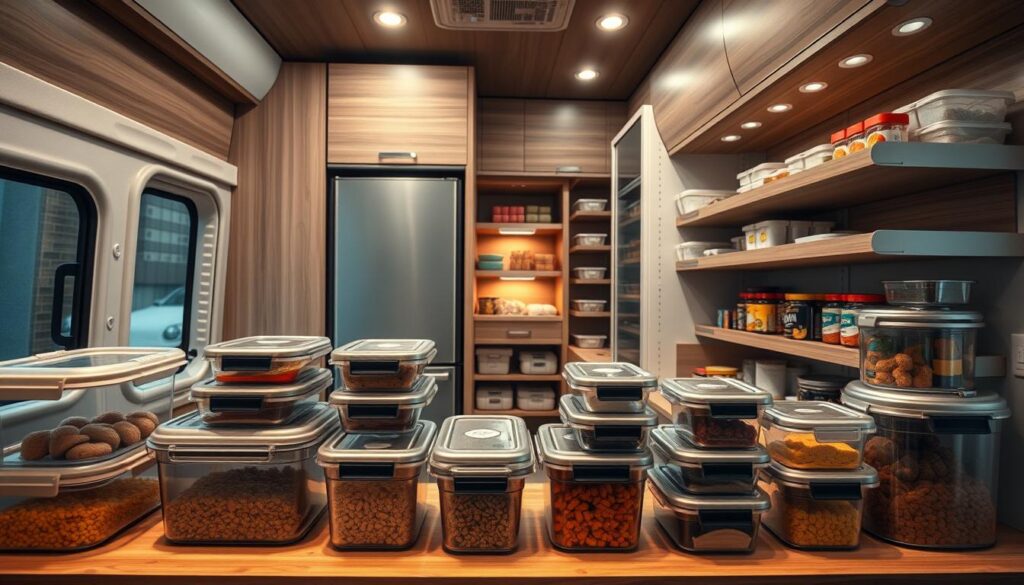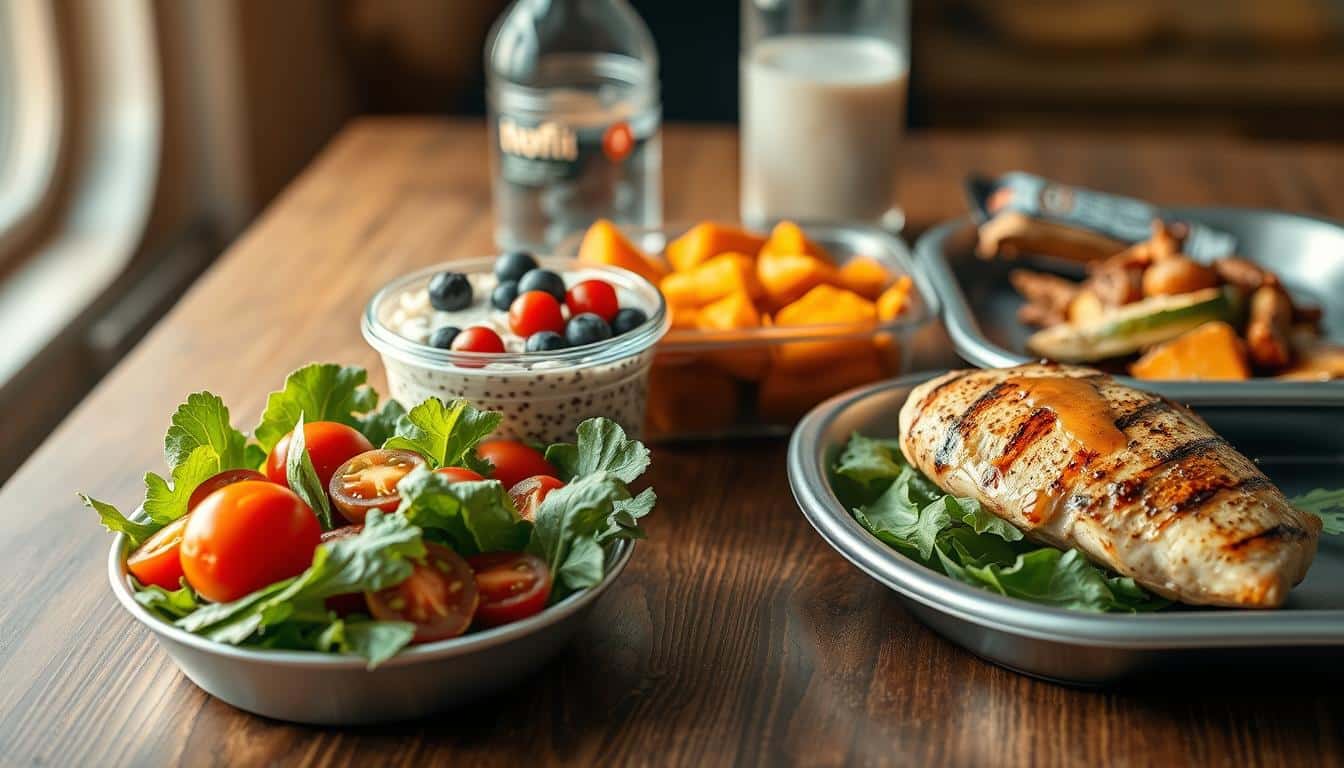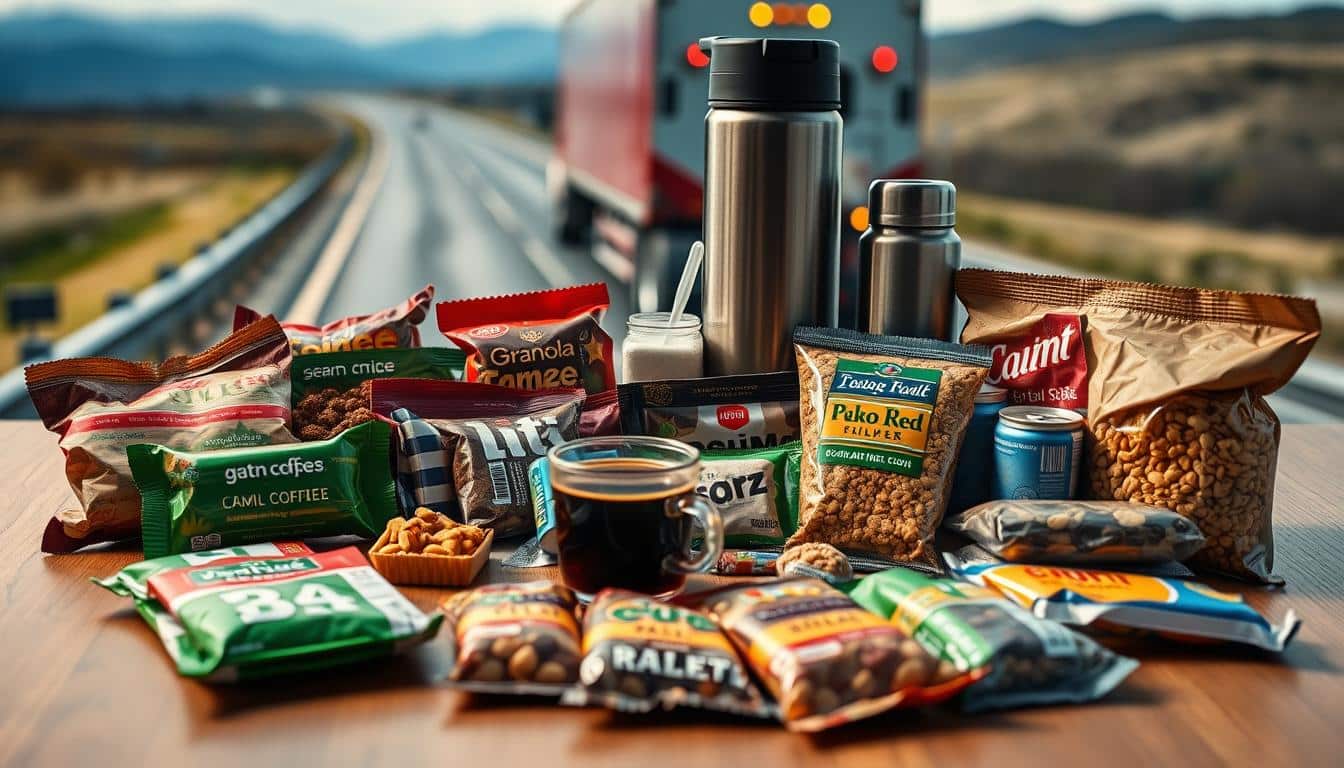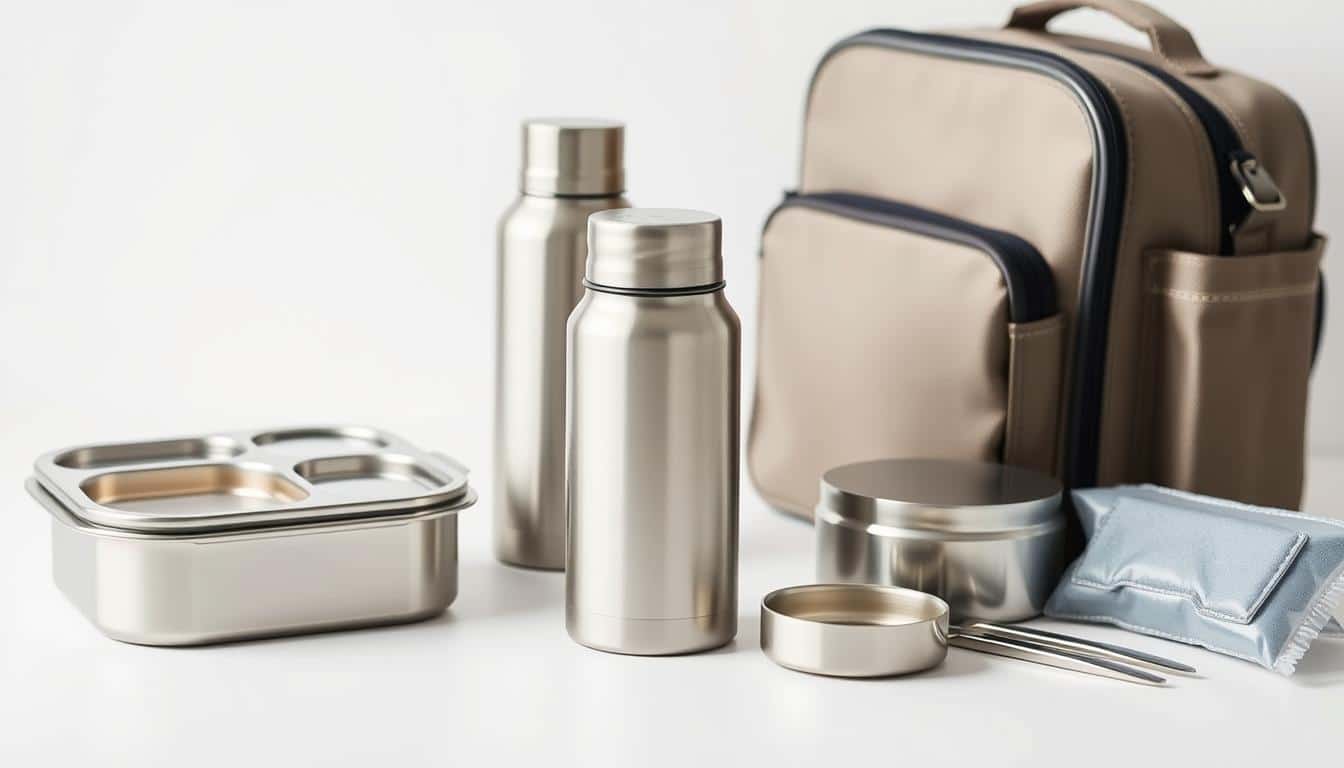Driving doesn’t mean you must settle for bad food. With the right gadgets, you can cook healthy meals right in your cab. This helps you eat well and saves money you’d spend at restaurants.
Important gadgets include refrigerators, microwaves, and electric skillets. You also shouldn’t forget about slow cookers, blenders, and coffee makers. These make cooking easy, even on long trips.
Some companies like Schneider provide fridges in their trucks. But, you can always add what you need. It’s vital to choose gadgets that fit your truck’s power availability. Most use 12V/24V or can run on 120V with an inverter.
This article will help you pick out, install, and use kitchen tools in your truck. This way, cooking on the road becomes safe, healthy, and cost-effective for every journey.
Why compact kitchen gear matters for life on the road
Drivers have to make do with little space. A well-thought-out truck kitchen keeps important things handy. It also reduces clutter and allows cooking in small areas. Picking small, stackable items means more room for sleep, paperwork, and personal stuff.
Choosing what to pack is crucial. Go for compact appliances like a small microwave or a tiny waffle maker. Stackable containers and pots that fit into one another save space without adding weight.
The kind of power your truck has is key to choosing appliances. Trucks usually have 12V or 24V outlets, and some have options for 120V. It’s best to choose appliances that fit your truck’s power setup. This way, you won’t need to rely too much on an inverter.
- Choose devices that use less power to keep breakers from tripping.
- Align inverter size with what you’ll actually need; 1000W to 1800W is a good range.
- For electronics that need it, use inverters that give a steady power output.
Eating well on the road saves money and boosts health. Drivers who cook in their trucks eat better and spend less on food. Focusing on easy-to-prepare proteins, veggies, and grains can make meals healthier. This helps truckers stay alert and feel good over time.
To make life simpler, organize your space well. Make sure things stay put while you drive, and choose items that serve more than one purpose. Planning meals based on your truck’s power helps too. Using power-hungry devices only when the engine is on keeps the battery from running out.
Refrigeration and freezer options for long hauls
Picking the best fridge for your truck helps with meals on long trips. It’s important to look at size, power needs, and how well it keeps things cold in a sleeper cab. Compare popular types, see dual-zone and 12V models for US trucks, and find tips on fixing and caring for your fridge on the road.
Mini-fridges vs. electric coolers: pros and cons
Mini fridges in semi-trucks often have a compressor. This means they keep a steady cold, might have a tiny freezer, and are good for keeping food on long journeys.
Electric coolers use a simpler tech and are lighter and cheaper. They’re okay for short trips or just drinks. Yet, they don’t do well as freezers in the heat.
- Mini-fridges: stay colder, can freeze, but use more power.
- Electric coolers: lighter, cheaper, but not as strong in hot weather.
- Choose compressor fridges if you need to freeze meals.
Dual-zone and 12V models that work in most US trucks
Dual-zone fridges can cool and freeze at the same time. They have separate spaces for fresh and frozen foods.
When shopping, look for a 12V or a model fit for 12–24V truck electrical setups. Make sure it fits your truck’s power and size needs before you buy.
- Dual-zone fridges: perfect for drivers needing both cool and frozen spaces.
- 12V fridges: designed for the truck’s outlets or direct wiring.
- Always check the specs and reviews for energy use and dependability.
Securing and maintaining a fridge in a moving cab
Fixing your fridge well stops sliding and lessens damage. Use fitting straps, L-brackets, or mounts for the fridge base.
Regular care keeps the cold constant and saves the battery. Defrost as needed, clean the seals, and watch the power to keep the battery running.
- Fixing: secure the fridge firmly to avoid movement.
- Manage power: use external power or run the engine at stops to save the battery.
- Care: maintain seals, clean when you can, and ensure it stays cold when moving.
Microwave and combination breakfast stations for quick meals
A compact microwave can be a game changer for drivers who need fast, hot meals without leaving the cab. Pick a model sized around 0.9 cu. ft. to fit most sleepers. Match its wattage to your inverter so you avoid tripping breakers or draining batteries. Consider a low-wattage microwave if inverter capacity is limited or if you plan to run multiple devices at once.
Space, power, and noise matter when you choose gear. Look for a breakfast station for truck use that bundles functions like microwave heating, a toaster slot, and an egg cooker. These combos save counter room and cut down on extra cords. Quiet operation and disable-beep options help keep rest periods peaceful.
Selecting wattage and capacity that won’t overload your inverter
Check the inverter’s continuous and surge ratings before buying. Many truck-friendly microwaves top out near 800W, which works if the inverter and engine support the load. Running the engine while using the microwave reduces risk to the truck battery. If your inverter is small, opt for a low-wattage microwave and shorter cook cycles.
Features that matter: silent mode, compact footprint, multi-function trays
Prioritize units with easy-to-clean interiors and dishwasher-safe trays. Multi-function trays let you steam, toast, and heat in one compact footprint. Silent or mute options remove annoying beeps. Low standby draw keeps power waste minimal when the unit is idle.
Meal ideas optimized for microwave cooking in a cab
- Breakfast burritos: assemble, wrap, and reheat for under two minutes.
- Microwave omelets: use a microwave-safe mug or tray for fast eggs.
- Steamable vegetables and frozen entrees: choose single-serve portions to reduce mess.
- Leftover bowls and single-serve casseroles: portion ahead for quick reheats.
Keep microwave meal ideas for truckers simple and prepped in portion-sized containers. Use microwave-safe dishes and avoid long cook times to save power. Pair a compact truck microwave with a multifunction breakfast station for truck drivers who need variety without clutter.
semi-truck kitchen gadgets
Setting up a sleeper cab means making smart choices. These choices help save space, power, and time. This guide includes essential items, advice on choosing versatile gadgets, and examples from drivers and their fleets across the United States.
What qualifies as must-have gadgets for truck drivers
The essentials for truck drivers focus on cooking, heating up food, storage, and cleaning. A fridge or freezer is a must. For quick meals, microwaves or electric lunch boxes are perfect. Slow cookers and electric skillets are great for bigger dishes or one-pot meals.
Don’t overlook smaller items. A travel spice rack, reusable food containers, and a small set of utensils make meals better and easier to clean up. A coffee maker helps start the day right.
How to choose multipurpose tools to save space and power
When picking kitchen tools for your truck, go for ones that serve more than one purpose. This reduces how many appliances you need. Consider getting a 3-in-1 breakfast station or a pressure cooker that doubles as an air fryer.
Choose appliances that use less power or plug into a 12V socket to easier on your inverter. Using stackable containers and collapsible utensils helps keep things organized. Pick items made for vehicles or those that can be securely mounted.
Examples from experienced drivers and fleet specs
- Fleets like Schneider often add fridges to sleeper trucks. Drivers like the Whynter 62 Quart model for its dual-zone space.
- Drivers often choose Nostalgia breakfast stations, Dash mini waffle makers (~350W), and the Buddew Electric Lunch Box (80W, 12V/110V) for easy heating.
- Electric skillets from Brentwood are popular for their versatility in cooking different dishes.
- For making smoothies or soups, portable blenders come in handy. Drivers recommend using appliances when the engine is running. They suggest inverters between 1000W and 1800W for the best performance.
For a streamlined kitchen set-up in your truck, start with a reliable fridge. Add one or two versatile cooking devices, secure storage, and a good coffee maker. This keeps your kitchen efficient and ready for the road, just like what professional fleets use.
Slow cookers, pressure cookers, and versatile multi-cookers
When you’re on the road for a long time, a small cooker can make cooking easy. You can start the cooker before your shift and come back to a warm meal. This guide looks at the pros and cons of slow cookers, quick pressure cookers, and multi-cookers for truckers.
Benefits of crockpots for set-and-forget meals
Slow cookers are great for stews, soups, pulled pork, and dishes that cook slowly. They let truckers prepare meals before they leave and keep them warm while driving.
When choosing one, look for small sizes with a “keep warm” setting and handles that don’t get hot. Models with two pots are useful for cooking sides or different meals at once.
Pressure cookers and multi-function units for faster cooking
Pressure cookers make meals much faster. Small electric ones and multi-cookers come with features like steaming, sautéing, and timed starts.
A multi-cooker can do the job of many appliances. Find one with clear wattage info; most small ones use about 700W. This matches well with typical inverters, but always check first.
Safety tips and power considerations while using slow appliances
- Make sure your inverter or 12V source can handle the appliance before using a pressure cooker or big slow cooker.
- Put the appliance on a surface that resists heat and make sure lids and handles are secure before driving.
- Use big appliances only when the engine is on or when connected to an external power source to save your truck’s battery.
- Don’t use several appliances that use a lot of power at the same time to avoid power failures and trips.
- Always follow what the manufacturer says for opening the pressure valve, sealing, and upkeep for safe cooking in your truck.
To cover all needs, drivers might find getting a small multi-cooker for different meals and a small crockpot best. Make sure to check the power needs and lock everything in place for safety during your journey.
Portable stovetops, electric skillets, and portable ovens
Lightweight cooking gadgets help drivers eat healthier on the go. They should fit in a sleeper cab, match the truck’s power, and be easy to clean. It’s smart to choose types that are easy to fasten down and make cooking safer.

Electric skillet advantages
Electric skillets heat evenly and let you control the temperature well. This is perfect for cooking eggs, making stir-fries, or preparing quesadillas. A model like the Brentwood SK-45 heats up quickly, has a sizable cooking area, and only needs a simple wipe to clean. It can replace many pans for truck drivers, saving time on meal prep.
To keep the skillet in good shape, use a silicone spatula. Metal tools can scratch it. Always power the skillet with shore power or a strong inverter. This keeps the truck’s battery from draining.
Two-burner and gas options
For those needing more heat, two-burner stovetops and butane or propane stoves do the trick. The Iwatani 35FW butane stove, for instance, offers quick and intense heat. These types of stoves can produce heat ranging from 10,000 to 30,000 BTU per hour.
Before bringing a stove with an open flame into your truck, check the rules. Many companies and local laws have restrictions about this. When allowed, keep extra gas canisters outside the sleeping area for safety.
Portable ovens and slow electric ovens
Compact electric ovens and 12V warmers fit well in trucks, as long as they match the vehicle’s power needs. These ovens cook food uniformly but slowly, so start them early. For single meals, electric lunch boxes that work on 12V power can heat food quicker.
Opt for models with covered heating elements and auto-off functions to lower the risk of fires. Always place these devices on surfaces that are flat and resistant to heat when they’re on.
Ventilation and cab cooking safety
Good airflow is crucial when using appliances that burn fuel. Keep a window open, turn on the cab fan, or use an exhaust outlet to maintain fresh air. Don’t leave cooking equipment on without watching it. Avoid using open flames in cramped spaces unless your vehicle and company policy permit it.
To cook safely in your cab, secure cords out of the way, place heat-resistant pads under hot items, and have a fire extinguisher meant for Class B/C fires close by. Whenever possible, use electric appliances for a safer cooking environment inside your cab.
Quick checklist for on-road cooks
- Prioritize an electric skillet for semi for everyday versatility.
- Confirm company policy before using a butane stove truck unit.
- Secure and level a portable stovetop for truck use to prevent spills.
- Use a portable oven for truck meals when you can allow extra cook time.
- Always follow cab cooking safety: ventilation, secure placement, and supervision.
Small specialty appliances: waffle makers, blenders, and hot pots
Small special appliances make mornings better in a sleeper cab. They don’t need much space or power. They help drivers make fresh breakfasts and drinks without getting out of the truck. Pick what fits your power limits and daily needs best.
Low-wattage waffle makers and easy breakfast recipes
A mini waffle maker is perfect for saving power. The Dash Mini Waffle Maker heats up quickly with its 350W power. It’s also easy to clean, especially since the plates come off. Check your inverter’s capacity if you pick a model that uses more power.
- Quick mix waffles are fast to make.
- Stuffed waffles can have fillings like ham or cheese.
- Try savory waffles with veggies and chicken for variety.
Personal and portable blenders for smoothies and soups
Travel-friendly personal blenders are small and battery-powered. A portable blender can mix single smoothies and double as your cup. They need 3-5 hours to charge but work well for multiple uses. This helps drivers include more fruits and veggies in their diets.
- Mix frozen fruit and protein powder for quick shakes.
- Blend veggies and broth for an easy soup.
- Have a small cutting board and bags for ingredients.
Hot pots and kettles for precise water heating and beverages
A hot pot that fits in cup holders is great for heating water. It plugs into your truck’s outlet. Great for making coffee, tea, or instant meals, but it might take up to 20 minutes to boil water. Plan your time.
- A hot pot is great for oatmeal or noodle cups.
- Filter water and check levels to stay safe.
- Keep your kettle secure to avoid spills on the road.
Here’s a tip: having a waffle maker, a blender, and a hot pot with you helps. They offer more breakfast options without using a lot of power.
Food storage, containers, and organization for semi-truck kitchens
Keeping truck food fresh makes the cab a nicer place to live. Use compact storage that fits well in small spaces. Durable items are best, so plan their storage spots ahead of time.

Use stackable and nestable containers to save space and reduce mess. Stainless steel is good for avoiding stains and smells. For liquids like soups, BPA-free plastic containers with tight lids are perfect. Nest lids inside each other to save even more space.
- Choose varied sizes for full meals, snacks, and sauces.
- Prefer clear or labeled lids so you can spot contents quickly.
- Keep a few insulated containers for hot or cold holds.
Labeling and portioning out food makes truck drivers’ meal prep easy. Divide your main course, grains, and veggies into daily servings for easy heating. Mark them with tape or erasable labels to keep track. This way, you can freeze meals without having to throw any away.
- Batch-cook soups, stews, and grains for multiple days.
- Create smoothie bags that are just the right size for your blender.
- Store snacks in single-serve containers to avoid overeating.
Keeping your cab’s storage secure helps avoid messes and breaks while driving. Non-slip mats and drawer dividers keep things in place. Store heavy items low to avoid accidents. Use leak-proof mugs and canisters to keep things tidy and pest-free.
- Bungee cords or cargo nets work well for open shelving.
- Drawer organizers stop small items from rattling loose.
- Clean up spills immediately to prevent odors and insects.
Choose airtight containers that stack well. Organize items by meal to make breakfast quick. Smart planning of truck food storage saves money over time. With good meal prep and secure storage, you’ll always be ready to eat, save money, and enjoy calmer times on the road.
Spices, utensils, and small accessories that elevate meals
Simple items can transform truck stop food into dishes you’re excited about. Carry lightweight gear that easily fits into small spaces. Your kit should include everything for seasoning, prepping, serving, and cleaning. This makes cooking in a cab quick and clean.
Begin with a compact spice rack designed for truckers. It should hold essentials like salt, pepper, and herbs. Choose containers that are refillable and spill-proof. This method keeps flavors at your fingertips without taking up too much room.
- Small magnetic tins for shelving
- Clear labels for quick identification
- A tiny tray or case to keep jars from rolling while driving
Select space-saving kitchen tools that are also effective. A collapsible knife or a sturdy one with a sheath is great for cutting. Include a silicone spatula, a serving spoon, and foldable bowls to minimize storage space.
- Chef’s or folding knife with a sharpener
- Silicone spatula and heat-resistant tongs
- Collapsible bowls, cups, and a compact cutting board
Choose dishware for the cab that’s easy to clean and store. Opt for lightweight, unbreakable materials like melamine or silicone. Use insulated mugs for hot drinks and aluminum pans for baking or disposable meals.
Bring along eco-friendly soap, a compact scrubber, and quick-dry towels for cleaning. A small drying rack saves space and makes drying easier. Keep all liquids in a sealed container to prevent spills on the road.
Gather all your cooking accessories in one place for easy access. Your kit should include spices, a dependable knife, a spatula, practical dishware, and cleaning supplies. This collection makes meals interesting, saves you time, and enhances your road life.
Power management and safe usage for onboard appliances
Good management of electricity in a sleeper cab is key to comfort and safety. It’s about mixing 12V devices with shore power or a strong inverter. This mix lets you stay flexible and safe without risking the truck’s start-up battery or delicate equipment.
Choosing between 12V/24V outlets or shore power depends on the appliance’s power needs and use time. Items like mini-fridges and hot pots work well on 12V. But, for high-power appliances like microwaves, you’ll need shore power or the right inverter.
If using big appliances while driving, keep the engine running or plug into shore power. This protects the battery from damage.
Choosing the right inverter
- Select an inverter that fits both your ongoing and peak power needs. Drivers often choose between 1000W and 1800W inverters for cooking.
- Look for pure sine wave inverters for your fridge, chargers, and sensitive gadgets. These prevent strange sounds and power losses you get with other types.
- Check the starting power needs of your appliances. Picking a too-small inverter can trip breakers and damage your devices.
Practical tips to avoid battery drain and ensure safe appliance use in cab
- Use high-power appliances when the engine is running or when hooked up to shore power.
- Avoid running too many devices at once. Timers and smart cookers help avoid leaving appliances on too long.
- Keep an eye on your battery’s power level using a meter or monitor. This helps catch any issues early on.
- Make sure appliances are secure. Put them on surfaces that resist heat and follow the safety tips from the maker.
- Before using microwaves or pressure cookers, check with your fleet’s rules. Also, make sure your inverter can handle the load.
For lots of drivers, the perfect setup combines efficient 12V appliances, a well-chosen pure sine inverter, and smart practices. This approach gives you more food options, protects the truck’s electric system, and keeps appliance use safe in the cab.
Conclusion
Packing a semi with the right kitchen tools can make eating on the road healthier and cheaper. Things like a good fridge, a microwave or electric lunch box, and a multi-cooker help make many meals. With a few extra items like a mini waffle maker, you can make your food choices even wider.
It’s smart to choose appliances that work with 12V/24V and don’t use too much power. Make sure to secure your gadgets when moving and use a good inverter to manage electricity. Doing this helps keep everything working smoothly while you’re on the road.
Choosing the right kitchen gear can help you eat better, save money, and feel more at home while traveling. Always follow safety rules and pick appliances that help make healthy meals easily. With a proper setup, cooking in your truck becomes a reliable way to improve your diet and wellness on long trips.
FAQ
What are the absolutely essential kitchen gadgets for a semi-truck sleeper?
Why prioritize compact, low-wattage or 12V-compatible gear for life on the road?
Mini-fridge or electric cooler — which is better for long hauls?
What should I look for in a dual-zone or truck-compatible portable fridge?
How do I secure and maintain a fridge inside a moving cab?
What microwave size and wattage work best in a truck sleeper?
Which microwave features matter most for in-cab use?
What microwave-friendly meal ideas work well for drivers?
Are crockpots and multi-cookers worthwhile for truck cooking?
What power and safety considerations apply to slow cookers and pressure cookers?
Are electric skillets or portable stovetops better for varied cooking?
What about portable ovens — do they make sense in a truck?
Which small specialty appliances are most useful for drivers?
How can I organize food, containers, and spices in limited cab space?
What are must-have utensils and small accessories?
How should I manage power: 12V/24V outlets, shore power, or an inverter?
Pure sine vs. modified sine inverters — which is better for truck kitchens?
How can I avoid draining the truck battery while cooking?
Which compact fridge and appliance models do drivers commonly recommend?
Are open-flame butane or propane stoves allowed inside sleeper cabs?
Any quick tips for meal-prep that save power and time on the road?
How do I keep appliances and food safe during transit and while parked?
Content created with the help of Artificial Intelligence.



